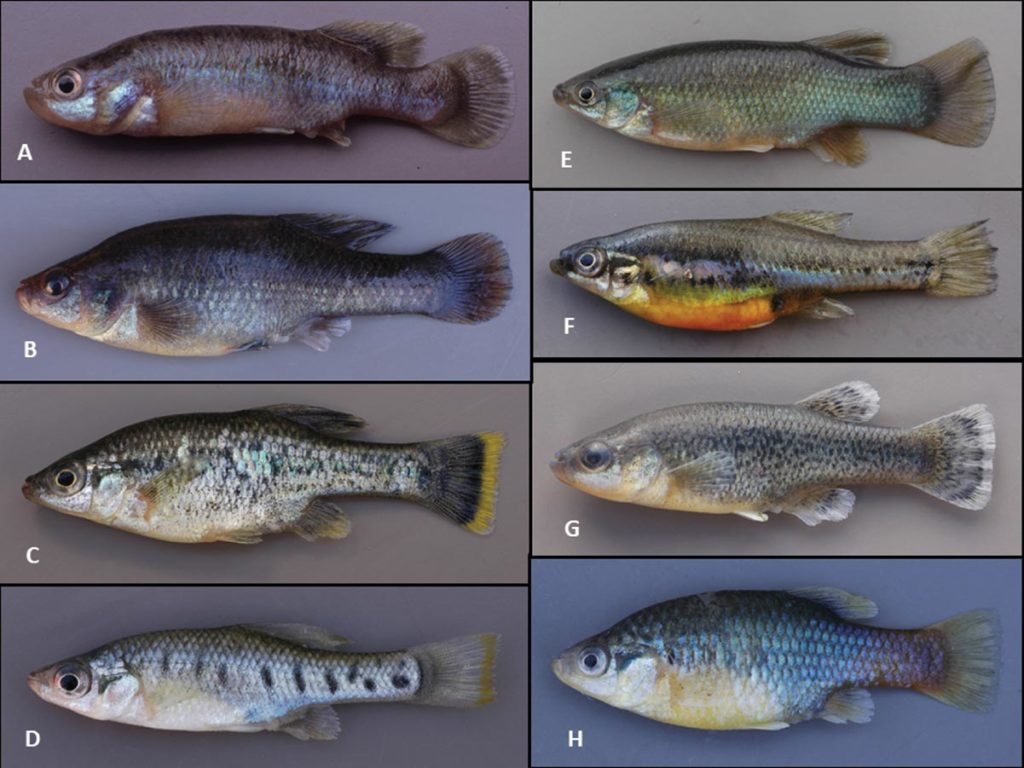
Some of Mexico’s most imperiled freshwater fishes: photos of eight representative goodeid fishes. All photos taken by John Lyons of freshly preserved, wild-caught, adult, male specimens. A) Allotoca goslinei, B) Alloophorus robustus, C) Ameca splendens, D) Chapalichthys encaustus, E) Goodea atripinnis, F) Skiffia lermae, G) Xenotaenia resolanae H) Xenotoca doadrioi. See the paper for full location data of these specimens. CC BY 4.0
The little livebearers collectively known as the goodeids (aka. splitfins) are perhaps a classic example of what some might call “little gray fish that almost no one cares about.”
Well, almost no one, save a handful of scientists and dedicated aquarists, many of whom are involved with the Goodeid Working Group, doing whatever they can to conserve these fishes both in the wild and in captive populations. While most are not terribly flashy, and almost none could ever be considered capable of starting a craze among the general aquarium hobby, the plight of the goodeids is often highlighted as one of the areas where the average home hobbyist can make a real difference. CARES Preservation List for the Goodeidae (Splitfins) currently lists 37 species of note for aquarists, and with today’s update, only four of Mexico’s splitfin species would qualify for the “least concern” rating used by the IUCN.

Primary author John Lyons is the Curator of Fishes at the UW Zoological Museum in Madison, Wisconsin.
Published today as an open-access article in the journal ZooKeys, Distribution and current conservation status of the Mexican Goodeidae (Actinopterygii, Cyprinodontiformes) combines the input of 10 co-authors to create a complete and timely census of these imperiled fishes. This article gives timely updates on the population status of 40 goodeids, and will certainly serve as a primary reference for anyone looking into the conservation of these endangered fishes.
John Lyons, the primary author, said of the project, “It was very educational, enjoyable, and productive working with the world’s experts on goodeid biology and conservation. I’m very happy with how the paper turned out. ”
Read the Abstract:
“The current distribution and abundance of the 40 species of Goodeidae fishes known from Mexico are described, and a total of 84 Evolutionarily Significant Units (ESUs) is designated within these species. Two species and four ESUs are likely extinct with no captive populations, and three species and eight ESUs are probably extinct in the wild but have at least one captive population in Mexico, the United States, or Europe. Of the 35 extant species, the analyses indicate that nine should be considered as critically endangered, 14 as endangered, nine as vulnerable, and only three as least concern. Twenty-seven of these species have experienced substantial declines in distribution or abundance or both since 2000, and only eight appear to have remained relatively stable. Of the 72 extant ESUs, our analyses indicate that 29 should be considered as critically endangered, 21 as endangered, 18 as vulnerable, and only four as least concern. Brief summaries of the historic and current distributions and abundance of each species are provided, as well as ESU. Three strategies are recommended to conserve Mexican goodeids: protect the best-quality remaining habitats where goodeids still persist, restore degraded habitat and re-introduce species or ESUs where practical, and establish captive populations to ensure continued survival of the many species and ESUs that will almost inevitably go extinct in the coming years. Limited resources require cooperation and collaboration between scientists, conservationists, and aquarium hobbyists for successful captive maintenance.”
Read the Paper:
To get the full story, or find detailed updates the species you’re most interested in, check out Distribution and current conservation status of the Mexican Goodeidae (Actinopterygii, Cyprinodontiformes) on ZooKeys. To learn what you can do to help goodeid conservation, consider checking out the Goodeid Working Group!
Reference:
Lyons J, Piller KR, Artigas-Azas JM, Dominguez-Dominguez O, Gesundheit P, Köck M, Medina-Nava M, Mercado-Silva N, García AR, Findley KM (2019) Distribution and current conservation status of the Mexican Goodeidae (Actinopterygii, Cyprinodontiformes). ZooKeys 885: 115-158. https://doi.org/10.3897/zookeys.885.38152





